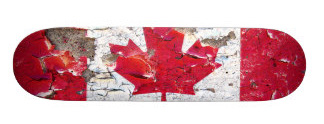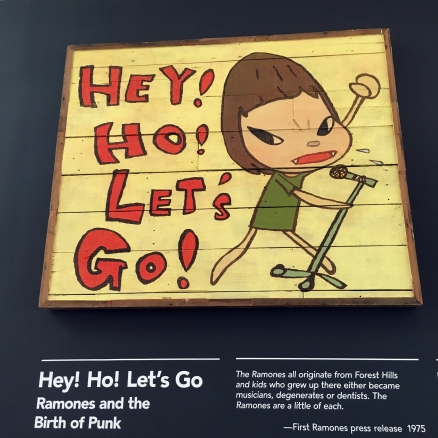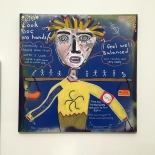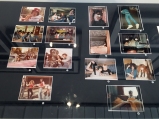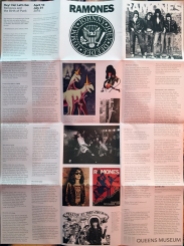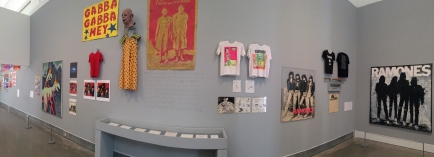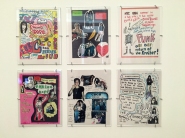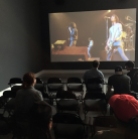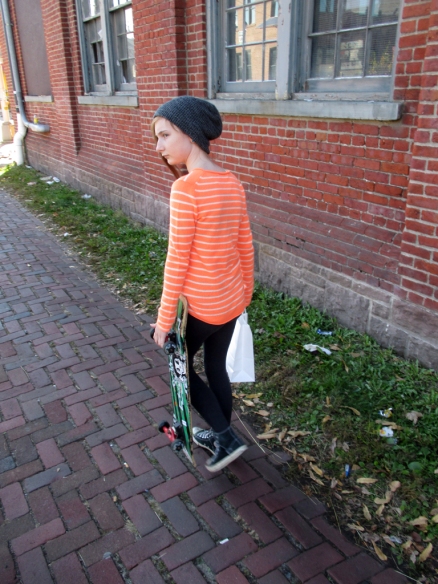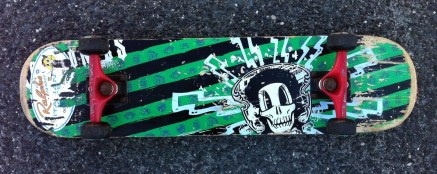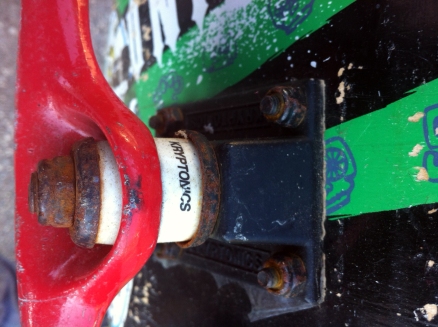
The Great Rock ‘n’ Roll Swindle (1980)
I’m a “classically trained” archaeologist with an interest in Punk history, and when I learned last week that something called the “Punk Rock Flea Market” was happening less than ten miles from my door, my imagination ran wild thinking of the Punk artifacts to be found. This advertisement threw gas on the fire:

Signage for the Punk Rock Flea Market, Nov. 8, 2015, Trenton, NJ.
DIY clip-art? Check. Icon on fire? Check. Records by the Damned, the Ramones, and NOFX present? Check. Music, art, and clothing? Check. “Punk Rock” Santa? Hmmmmm….
Part of Punk Archaeology is understanding the material culture of Punk. I figured the Punk Rock Flea Market would have this in spades, and that I’d be rummaging through boxes of vintage clothes, collections of tapes and records, old patches and stickers, photos, ‘zines, memorabilia, ephemera, a veritable Turkish bazaar of Punk. I wasn’t necessarily looking to buy anything, but I was curious what would be on display, how it would be presented, who would be selling, and who (if anyone) would come.
Trenton is the capital of New Jersey and is really kind of the state’s mini-Detroit, a center of manufacture (hence the slogan, “Trenton Makes; the World Takes” on a bridge into town), dotted with urban blight, and a place that is in many parts dangerous and impoverished, but surrounded by affluent suburbs and towns such as Princeton a stone’s throw away. The mix of urban desperation and suburban boredom help make Trenton a New Jersey Punk nexus with its famous club, City Gardens. New Jersey is a small state, bookended by major metro areas of Philadelphia and New York City, and for the kids who couldn’t make it into town, the New Brunswick basement scene was world-class. What Punk relics from New Jersey’s Golden Age of Punk awaited me and my 12-year-old daughter? We had to wait to find out.

We all did what we were told at the Punk Rock Flea Market.
Our Punk hajj found us at the back of a huge line, as if we were waiting for general admission entry to a club show. The line featured people of all ages, many of whom came dressed for the occasion, reaching back into their closets for studded leather or at least a ripped pair of jeans and dusty Doc Martens. It was a kind of Punk cosplay in a way, but there were a few people here and there who looked like they had been in the middle of it all and emerged intact, remaining quite serious to Punk’s social and political messages.

Part of the line waiting to get in to the Punk Rock Flea Market, Roebling Wire Works, Trenton, NJ.
We walked the full perimeter of the Roebling Wire Works, an abandoned factory now rented out for concerts, film screenings, photo- and video-shoots, and events such as this one. We got a peek inside as we based the back door with a view into the cavernous, basilica-like space within, already full of people, Punk on the loudspeakers. The rawness of Punk and the link to an abandoned factory in a rough town appealed. They go well together.
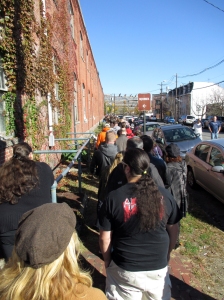
The line for entry ($4) to the Punk Rock Flea Market wrapped all the way around the Roebling Wire Works.
As the line wound around the building, we were handed flyers and postcards. I expected to see some political activism, campaigning, social justice issues, and more, but there was none of this side of Punk. Punk is activism in many forms, just as Punk Archaeology has an activist wing, but this activism was completely absent both outside and within the venue. I was hoping my daughter would see people registering others to vote, or promoting vegetarian/vegan living, but all we got were cards promoting shows and the April 2016 edition of the Punk Rock Flea market. Standing outside, you would never know what Punk was about, but those who knew (or at least were curious) came. The parking lot was full.

The exterior of the Punk Rock Flea Market’s venue showed promise.
Broken windows offered us glimpses inside of Punk memorabilia and DIY crafts. As we rounded the final corner to enter, we were met with a riff on Shepard Fairey’s “Obey” art. Social media was here and in full effect. That’s how I found out about it. I remembered seeing (and still do see in New York) stickers and promotional handbills advertising bands and shows. Those paper and vinyl reminders are quite likely things of the past now. Social media is free, and it’s everywhere, but it leaves no trace.

Shepard Fairey art co-opted for advertising the Punk Rock Flea Market.
It cost me $8.00 to get the two of us in. We had to spend money in order to spend more money, but I understand that the funds go to pay for the rental of the building and the payment of event staff. Once inside, I was amazed at how crowded it was, but also how bright.

Inside the old Roebling Wire Works, Trenton, NJ, for the Punk Rock Flea Market.
Over 200 vendors lined the factory floor, and the preliminary offerings of Punk stuff left me cold and feeling like I’d been had. The DIY crafts included things that smelled nice: candles, incense, aromatherapy oils. I found myself wondering in what context aromatherapy was Punk, but it was here, so by association, it was Punk. I thought back to the Markets of Trajan in Rome where modern tourists consider the architecture only, but can hardly imagine all of the activity and commerce within. Here in the abandoned factory, we had invented a space out of time, something temporary but undoubtedly commercial. We observed but also participated.The flea market was a commercial event, and I began to realize that this wasn’t a place like Plaka in Athens where I could dip my hands into history. Most of the stalls had new, handmade things, but things that co-opted Punk logos and language to move a product.
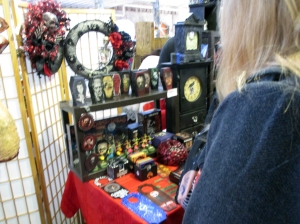
Coffins! Get your hand-painted Punk rock coffins at the Punk Rock Flea Market!
The case-in-point were the endless knick-knacks featuring band names and iconic Punk images (how many ways can you use a Danzig skull?). Hand-painted mini-coffins were for sale in at least two stalls. There were needlepoint crafts with the cartoon head of Milo from the Descendents. Sex Pistols oven mitts? You got ’em! I imagined these bands, most of whose members are still alive, and what they would think of all this, how their earnestness and energy transformed from an emotion into something to put on a shelf. Punk in general appeared to be outwardly anti-commercial, but promoters/managers such as Malcolm McLaren realized early on that everything is about money. It’s the great rock ‘n’ roll swindle. And here in Trenton is the Punk Rock Flea Market to prove it.
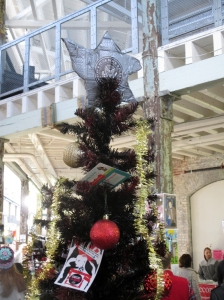
The Punk Rock Flea Market Christmas tree.
In the center of it all stood a tired, fake Christmas tree, underneath which was plenty of free swag and flyers to take.

“Punk Rock” Santa
The “holiday edition” of the PRFM also featured a “Punk Rock” Santa who wore a studded leather belt, and a red coat sewn with Punk patches. I half-expected to see a hungover, smoking guy in a hat telling children to piss off, or at least singing the Kinks’ “Father Christmas” song, but none of that was happening. There were the superficial trappings of Punk, but nothing deeper. We could see at least part of the Punk uniform, but worn strictly for show, iconography communicating on its own, separate from the person wearing it.
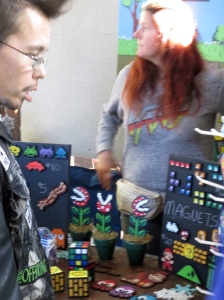
Jaw-dropping 1980s perler bead art of 1970s and 1980s pop culture at the Punk Rock Flea Market.
But what about the artifacts? Where were the Punk relics? We first had to wade through crowds surrounding DIY vendors featuring 1980’s memorabilia. As the 1970s and 1980s (and to some extent the early 1990s) were the decades for Punk and later hardcore, all of the trappings of that age made an appearance, triggering nostalgia. The amount of stuff to buy was staggering, but also unnecessary in a way. This was full-on commercialism and carried no message deeper than “weren’t the ’80s fun?”. I expected to see at least some anti-Reagan paraphernalia, and things condemning Margaret Thatcher, shirts or stickers sporting anti-fascist slogans, and in-your-face confrontational language. I saw none of it. There was no protest or anger. This perhaps is one of the problems with attending a show like this with the experience of having lived through the Punk era (even as a kid). We kept walking.
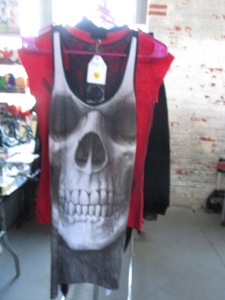
If it has a skull on it, it’s Punk fashion. Yours for $40 at the Punk Rock Flea Market.
I had hoped to get my daughter some Punk clothes, or at least clothes that she could work with as she creates her own personal fashion identity: Punk was fashion after all; there was a uniform and shared iconography. The few clothes we found were vintage in a way, but little in the way of jackets or accessories or old band shirts. Pins and patches could be found, but these were alongside high-end Punk-inspired clothing and handbags. Skulls were popular. One might assume that skull = Punk. We continued on.
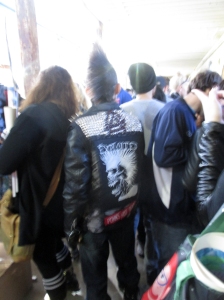
Exploited at the Punk Rock Flea Market.
We saw exactly one mohawk haircut in affect. The fashion at the Flea Market ranged from Wal Mart weekend to more elaborate Goth and emo, with plenty of black jeans and jackets, heavy eyeliner, blue hair (on young people), back t-shirts. People behaved, and they shopped. Quietly.

Atari games, VHS tapes, a new generation Intellivision, a Walkman, and more from the 1980s at the Punk Rock Flea Market.
In the back-half of the Roebling Wire Works, we did begin to find ephemera and collectibles, authentic toys and media from the 1980s specifically. One vendor featured classic video games and hardware along with VHS and audio tapes and devices on which to play them (my daughter correctly identified a Walkman). All of these were presented without any real context, although they were presented together as a collective assemblage of artifacts from a 10-year span of American history. Ours was (and continues to be) a media-driven culture with entertainment featured in a program of planned obsolescence.

1980s ephemera, Punk Rock Flea Market
One particular display caught my eye, with toys from my later adolescence. And then I saw it:

Reproduction idol from Raiders of the Lost Ark.
A coin-bank in the shape of the idol from Raiders of the Last Ark. I had to have it. Although not Punk, it would be perfect for my desk. Nostalgia captured me, but not strong enough to liberate $80 from my wallet. History has a price, even if it is recent and made of plastic.

Shuffling through the Roebling Wire Works at the Punk Rock Flea Market.
We continued to shuffle, and it reminded me of the schoolchildren in “Another Brick in the Wall: Part 2” from Pink Floyd’s The Wall film, hordes of people filing up and back in lock-step, eyes vacant because of the sameness and abundance of everything to buy.
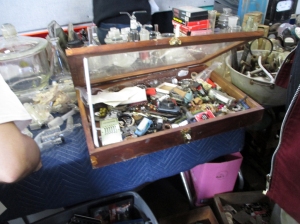
Table of non-Punk curiosities from several pre-Punk eras.
Two vendors featured antiques from the 19th and early 20th centuries, but this pre-Punk material was largely ignored. I was curious as to why it was here, an anachronism to Punk history, an intrusion or contamination of sorts into the level in which I was interested.

Co-opted logos and Punk art turned into . . . lamps.
We continued to slog, continually battered by Punk repackaged into household goods such as lamps in the shapes of people, but covered in old Punk messages. Punk hardware used to be just a lighter and maybe a wallet chain, but now you can outfit your home in Punk-inspired furnishings. My archaeological objectivity had reached its bitter end.
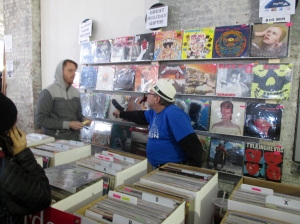
More by-god vinyl at the Punk Rock Flea Market. Bowie was everywhere….
There was hope, however, in the few record stands we found. Each of the three specialized in vinyl, and they had brought their very best from the ’70s and ’80s, with Punk, New Wave, hardcore, and some heavy metal. The record-sized crates and boxes had a shared familiarity, as well as the smell of paper, plastic, and vinyl that cannot be mistaken for anything else in the world. Here was Punk (or a major part of it) presented as collectible artifact. All of these stands also had collections of CDs from new, underground Punk bands, as well as cassettes and demos from bands unknown and also famous (e.g., Bikini Kill). I had hoped to be able to dive into bins of hand-labeled cassettes and mixtapes, but there were none to be had.

Black Flag was everywhere at the Punk Rock Flea Market. As was Billy Idol.
Some of the music vendors had promotional records, test-pressings, 7″ singles, and more, and everything was priced for a collector’s market. Punk has a price, and the rarer something is, the more expensive it becomes. These Punk recordings are commercially no different than ancient pottery or rare coins. Different media, but the same concept.

Punk rock (and other) records at the Punk Rock Flea Market.
Some record vendors were bigger than others, but the pricing was similar, and the selection was homogenized. They knew their market and what would appeal.
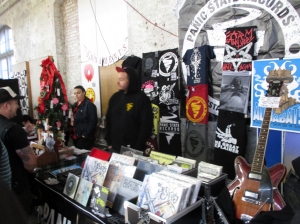
Panic State Records, a New Brunswick, NJ vinyl-only Punk/hardcore record label, was out in force at the Punk Rock Flea Market.
One of the most interesting places (to me at least) in this Zen Arcade was the booth for Panic State Records of New Brunswick, New Jersey. This vinyl-only label continues to produce new Punk and hardcore records for local, state, and regional bands, with proceeds going to various charities.
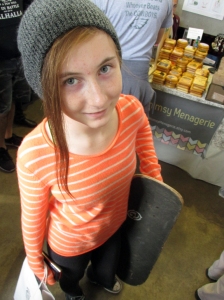
My daughter with her $12 skateboard
We ultimately did buy something. At one of the Punk stands featuring skateboarding memorabilia, I grabbed my daughter a skateboard (deck, wheels, and trucks) for $12. She was delighted with the artifact that had certainly been enjoyed by its previous owner. Artifacts have their own biographies and histories of use, and she is about to add another chapter with this board. Look for a future blog post on this skateboard-as-artifact coming soon.

Llama Skull Raffle: DIY Signage
The only stall inside with a hint of a cause was a taxidermist specializing in animal skulls with the DIY sign stating that raffle tickets for a llama skull were only $1, and that all of the money would go to greyhound rescue. Now that the Punk Rock Flea Market is over, I wonder what has happened to the sign. It was created and displayed for the event, but is now likely destroyed or discarded as trash, a temporary message for animal welfare. Thinking about this more, perhaps most of Punk was ephemeral, more zeitgeist than material culture, especially with everyday things from individual people who were participants (active or passive) and consumers of what Punk was to them in their towns for that time. Where did those personal collections go, little things like ticket stubs, or hand-altered clothes decorated all over with permanent marker? These things were not here in Trenton.
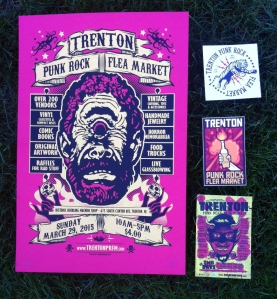
The best swag to be had from the Punk Rock Flea Market was its own self-aware signage and stickers.
One of the clearest messages about the Punk Rock Flea Market was that it is aware of itself. The hype was real, and did an excellent job in getting people out of their homes/cars to come and shop. The graphic design was classic Punk. I picked up a hand-printed and numbered handbill for last spring’s event, along with a postcard and a couple of stickers. I also bought a black hoodie sweatshirt with a logo on the front approaching Ed Roth quality of design. The coolness being comunicated by these objects is that there is such a thing as the Punk Rock Flea Market. It’s an idea, a concept, a pitch, and creates an emotion through design that evokes nostalgia and curiosity. Punk was always clear with its message and with knowing just how to promote itself (and to whom to promote it to), how to target emotions and push buttons to motivate people to action. In this respect, the Punk Rock Flea Market was a huge success. But once inside, that promised magic faded with the exception of the music, which continues to promote a certain set of ideals. Loudly.

Inside the Roebling Wire Works for the Punk Rock Flea Market, Trenton, NJ
-Andrew Reinhard
40.217053
-74.742938
Posted in fieldword, punk archaeology
|
Tagged archaeology, punk archaeology, punk rock flea arket
|
